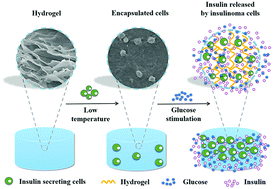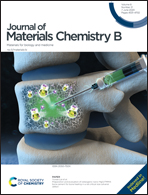A bio-inspired injectable hydrogel as a cell platform for real-time glycaemic regulation†
Abstract
Frequent subcutaneous insulin injection and islet transplantation are promising therapeutic options for type 1 diabetes mellitus. However, poor patient compliance, insufficient appropriate islet β cell donors and body immune rejection limit their clinical applications. The design of a platform capable of encapsulating insulin-secreting cells and achieving real-time blood glucose regulation, is a so far unmet need. Herein, inspired by the natural processes of regulating blood glucose in pancreatic islet β cells, we developed a poly(N-isopropylacrylamide-co-dextran-maleic acid-co-3-acrylamidophenylboronic acid) (P(AAPBA–Dex–NIPAM)) hydrogel as a cell platform with glucose responsiveness and thermo-responsiveness for the therapy of diabetes. This platform showed good biocompatibility against insulin-secreting cells and presented glucose-dependent insulin release behaviour. The bioinspired P(AAPBA6–Dex–NIPAM64) hydrogel had a positive effect on real-time glycaemic regulation, as observed by intraperitoneal glucose tolerance tests. The non-fasting blood glucose of diabetic rats was restored to a normal level during the period of treatment. Additionally, the inflammatory response did not occur after administration of the platform. Collectively, we expected that the bio-mimetic platform combined with an insulin-secreting capability could be a new diabetic treatment strategy.



 Please wait while we load your content...
Please wait while we load your content...